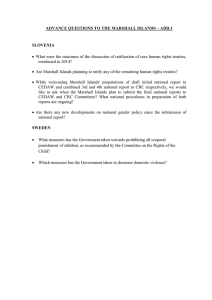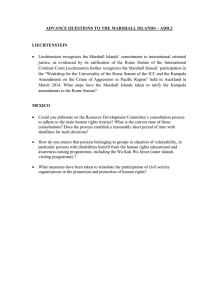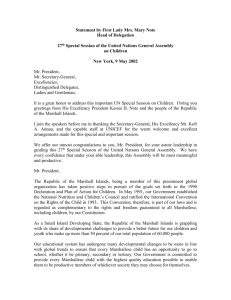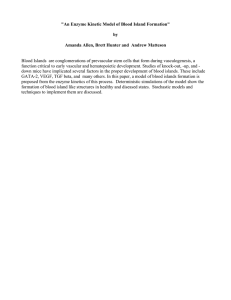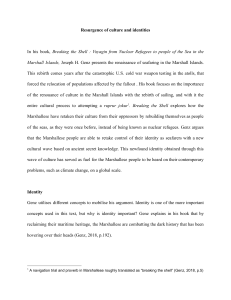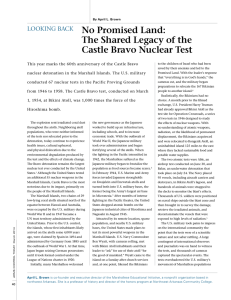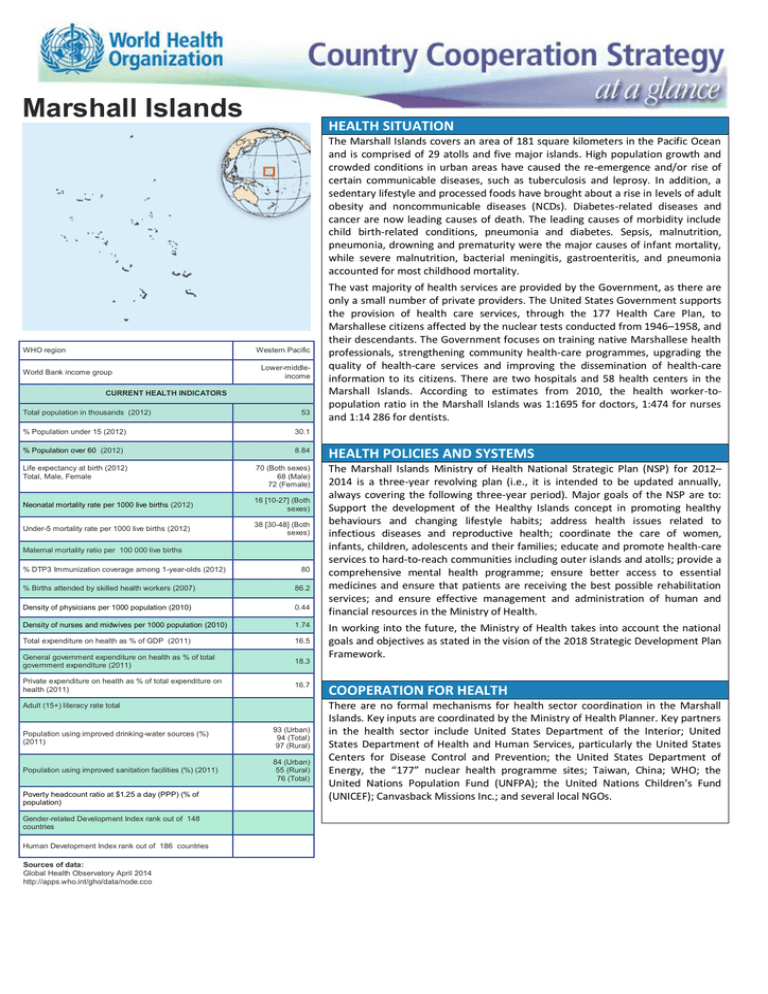
Marshall Islands
HEALTH SITUATION
The Marshall Islands covers an area of 181 square kilometers in the Pacific Ocean
and is comprised of 29 atolls and five major islands. High population growth and
crowded conditions in urban areas have caused the re-emergence and/or rise of
certain communicable diseases, such as tuberculosis and leprosy. In addition, a
sedentary lifestyle and processed foods have brought about a rise in levels of adult
obesity and noncommunicable diseases (NCDs). Diabetes-related diseases and
cancer are now leading causes of death. The leading causes of morbidity include
child birth-related conditions, pneumonia and diabetes. Sepsis, malnutrition,
pneumonia, drowning and prematurity were the major causes of infant mortality,
while severe malnutrition, bacterial meningitis, gastroenteritis, and pneumonia
accounted for most childhood mortality.
WHO region
Western Pacific
World Bank income group
Lower-middleincome
CURRENT HEALTH INDICATORS
Total population in thousands (2012)
53
% Population under 15 (2012)
30.1
% Population over 60 (2012)
8.84
Life expectancy at birth (2012)
Total, Male, Female
70 (Both sexes)
68 (Male)
72 (Female)
Neonatal mortality rate per 1000 live births (2012)
16 [10-27] (Both
sexes)
Under-5 mortality rate per 1000 live births (2012)
38 [30-48] (Both
sexes)
Maternal mortality ratio per 100 000 live births
% DTP3 Immunization coverage among 1-year-olds (2012)
80
% Births attended by skilled health workers (2007)
86.2
Density of physicians per 1000 population (2010)
0.44
Density of nurses and midwives per 1000 population (2010)
1.74
Total expenditure on health as % of GDP (2011)
16.5
General government expenditure on health as % of total
government expenditure (2011)
18.3
Private expenditure on health as % of total expenditure on
health (2011)
16.7
Adult (15+) literacy rate total
Population using improved drinking-water sources (%)
(2011)
93 (Urban)
94 (Total)
97 (Rural)
Population using improved sanitation facilities (%) (2011)
84 (Urban)
55 (Rural)
76 (Total)
Poverty headcount ratio at $1.25 a day (PPP) (% of
population)
Gender-related Development Index rank out of 148
countries
Human Development Index rank out of 186 countries
Sources of data:
Global Health Observatory April 2014
http://apps.who.int/gho/data/node.cco
The vast majority of health services are provided by the Government, as there are
only a small number of private providers. The United States Government supports
the provision of health care services, through the 177 Health Care Plan, to
Marshallese citizens affected by the nuclear tests conducted from 1946–1958, and
their descendants. The Government focuses on training native Marshallese health
professionals, strengthening community health-care programmes, upgrading the
quality of health-care services and improving the dissemination of health-care
information to its citizens. There are two hospitals and 58 health centers in the
Marshall Islands. According to estimates from 2010, the health worker-topopulation ratio in the Marshall Islands was 1:1695 for doctors, 1:474 for nurses
and 1:14 286 for dentists.
HEALTH POLICIES AND SYSTEMS
The Marshall Islands Ministry of Health National Strategic Plan (NSP) for 2012–
2014 is a three-year revolving plan (i.e., it is intended to be updated annually,
always covering the following three-year period). Major goals of the NSP are to:
Support the development of the Healthy Islands concept in promoting healthy
behaviours and changing lifestyle habits; address health issues related to
infectious diseases and reproductive health; coordinate the care of women,
infants, children, adolescents and their families; educate and promote health-care
services to hard-to-reach communities including outer islands and atolls; provide a
comprehensive mental health programme; ensure better access to essential
medicines and ensure that patients are receiving the best possible rehabilitation
services; and ensure effective management and administration of human and
financial resources in the Ministry of Health.
In working into the future, the Ministry of Health takes into account the national
goals and objectives as stated in the vision of the 2018 Strategic Development Plan
Framework.
COOPERATION FOR HEALTH
There are no formal mechanisms for health sector coordination in the Marshall
Islands. Key inputs are coordinated by the Ministry of Health Planner. Key partners
in the health sector include United States Department of the Interior; United
States Department of Health and Human Services, particularly the United States
Centers for Disease Control and Prevention; the United States Department of
Energy, the “177” nuclear health programme sites; Taiwan, China; WHO; the
United Nations Population Fund (UNFPA); the United Nations Children’s Fund
(UNICEF); Canvasback Missions Inc.; and several local NGOs.
WHO COUNTRY COOPERATION STRATEGIC AGENDA (2013-2017)
Strategic Priorities
Main Focus Areas for WHO Cooperation
STRATEGIC PRIORITY 1:
Address the prevention and control of NCDs, including implementation of national tobacco
regulations; mental health and legislative frameworks for food quality, safety and enforcement
capacities; and improve community awareness about healthy eating and lifestyles.
STRATEGIC PRIORITY 2:
Strengthen surveillance for vaccine-preventable diseases, delivery of immunizations and capacitybuilding of mid-level Expanded Programme on Immunization (EPI) managers, as well as strengthen
means to prevent communicable diseases, including climate change- related issues such as
improved drinking-water safety planning and rainwater harvesting, as well as household and
community-based water-quality monitoring.
STRATEGIC PRIORITY 3:
Strengthen the coordination of care for maternal and child health and reproductive health.
STRATEGIC PRIORITY 4:
Strengthen the pharmaceutical sector through development and monitoring the national
medicines policy and pharmaceutical strategic plan, with an emphasis on increasing access.
STRATEGIC PRIORITY 5:
Scale up health workforce production, improving performance, and reduce imbalances in skill mix
and distribution with a focus on reaching areas with limited access.
© World Health Organization 2014 - All rights reserved.
The Country Cooperation Strategy briefs are not a formal publication of WHO and do not necessarily represent the decisions or the stated policy of the Organization. The presentation of maps
contained herein does not imply the expression of any opinion whatsoever on the part of WHO concerning the legal status of any country, territory, city or area or of its authorities, or concerning the
delineation of its frontiers or boundaries.
WHO/CCU/14.03/Marshall Islands
Updated: May 2014

